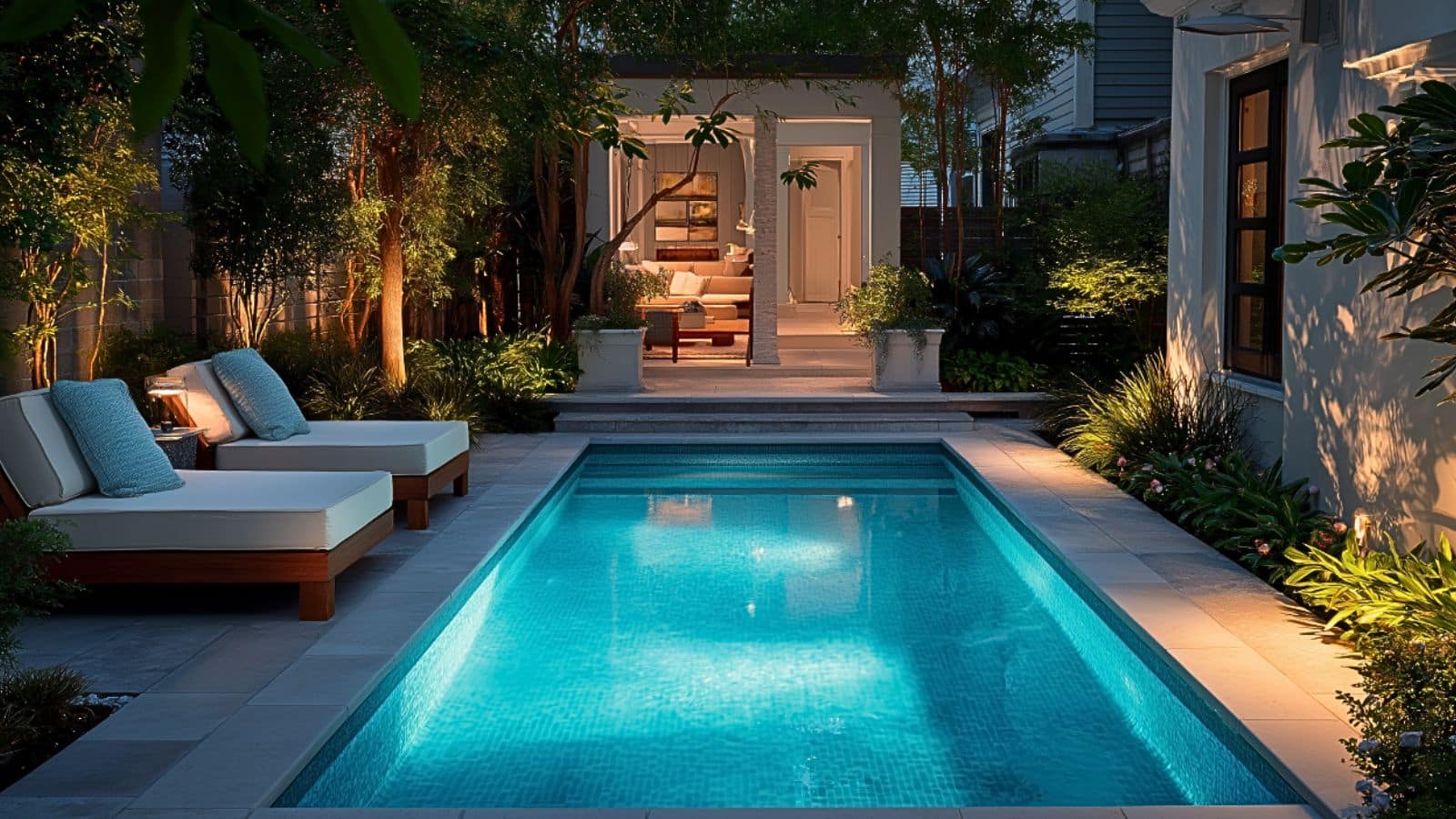How to Design Small Pools for Small Yards That Impress with Style and Function
Table of Contents
Can a compact backyard really host a stunning pool? Absolutely. As outdoor living continues to evolve, small pools—also called plunge pools or cocktail pools—are emerging as must-have features in even the tiniest of yards. According to recent landscaping trends, interest in compact pool designs has risen nearly 200% in urban and suburban areas. The takeaway? Size no longer limits style or impact.
Designing a small pool for a small yard may seem challenging, but it’s also an opportunity to get creative. With thoughtful planning, the right materials, and a clear sense of purpose, even the most modest outdoor spaces can become resort-worthy retreats. The key lies in maximizing functionality while maintaining visual elegance.
This article will guide you through how to design a small pool that looks impressive and performs beautifully. You’ll discover layout strategies, smart material choices, space-saving features, and styling tips that make a splash. Whether your aesthetic leans modern, Mediterranean, or organic, these ideas will help you transform a small yard into a showstopping oasis. Let’s dive into how to do more with less—and do it with style.
Start with a Purpose-Driven Pool Design
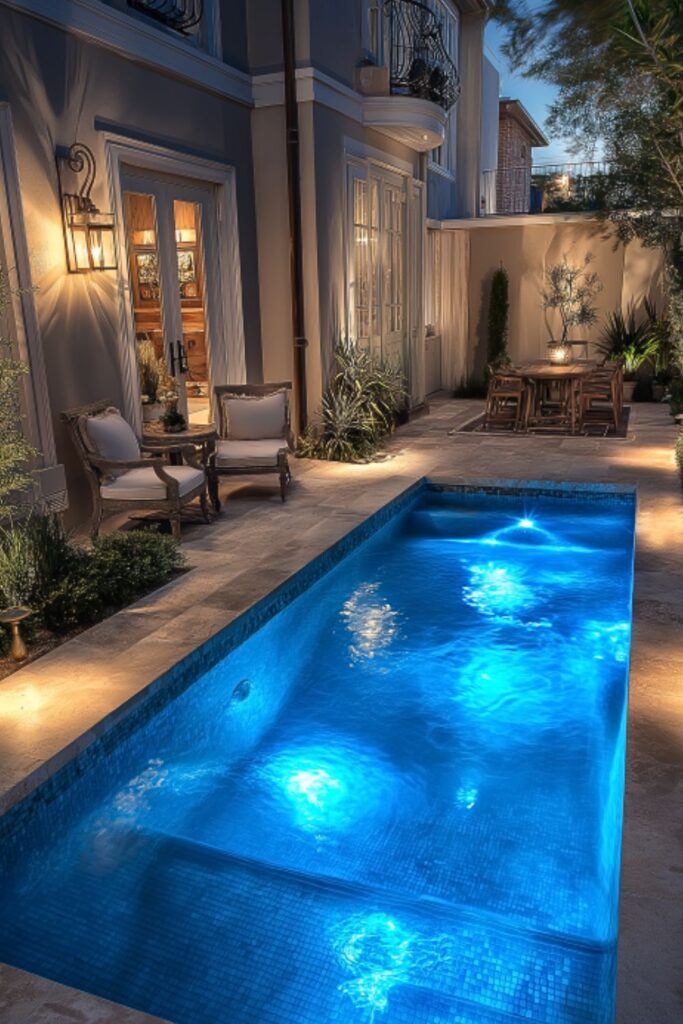
Before choosing tile colors or decking, define what you want your small pool to do for your lifestyle. Will it be a relaxing plunge pool for hot afternoons? A visual focal point for your patio? A spot for hydrotherapy or low-impact workouts? Purpose informs design.
In compact yards, every square foot counts. A pool with a defined role ensures better use of space and helps prioritize features like built-in seating, jets, heating, or lighting. For instance, if relaxation is your goal, a smaller depth with integrated loungers or a waterfall feature enhances ambiance. If your priority is exercise, a narrow lap pool or resistance jets may be more appropriate.
Additionally, understanding the flow between indoor and outdoor spaces helps the pool feel intentional—not just squeezed in.
Design Planning Table:
| Pool Purpose | Ideal Features | Design Style Match |
|---|---|---|
| Relaxation | Shallow depth, jets, heating, mood lighting | Spa-style, Mediterranean |
| Aesthetic Feature | Reflective surface, modern edging | Minimalist, Zen-inspired |
| Exercise | Long and narrow, swim jets, clean lines | Modern, functional |
| Family-Friendly | Safety edges, step-in ledge, shallow shelf | Transitional, cozy |
Choose a Shape That Enhances the Space
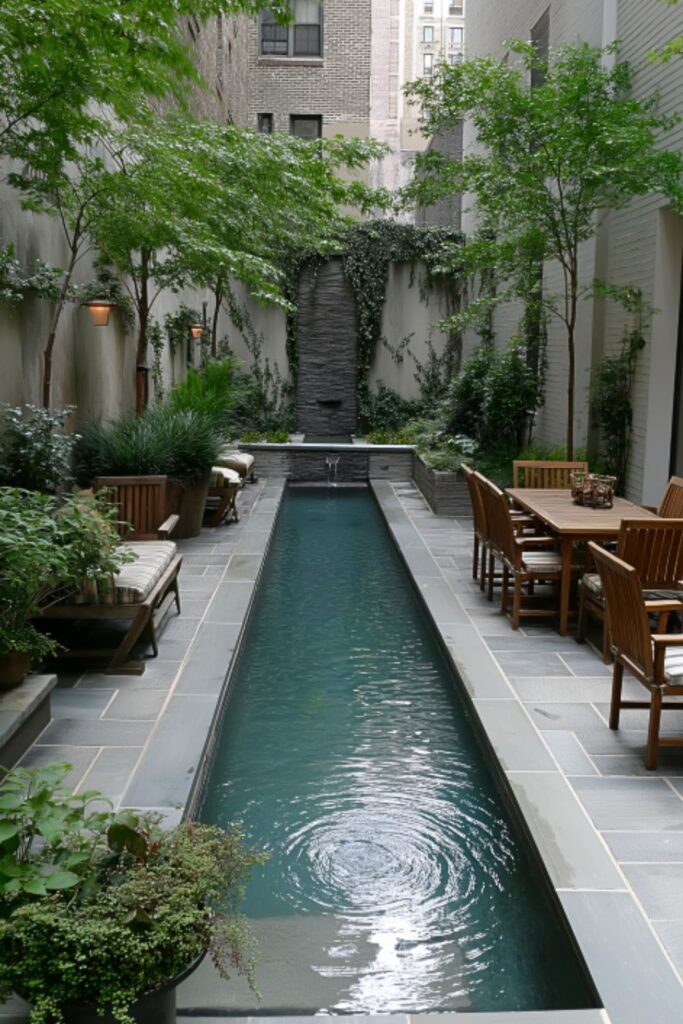
The shape of your small pool can influence the entire layout of your yard. While traditional rectangular pools remain popular, curves and custom angles may better fit irregular spaces and create a more organic look.
Rectangular pools offer a sleek, modern appearance and are ideal for narrow yards or side spaces. They also pair well with linear architecture and make swim lanes more practical. Round or oval pools soften the space, promote flow, and evoke a spa-like serenity—great for courtyard layouts. Freeform pools, while harder to design in small yards, can work beautifully in lush, natural landscapes.
Choose a shape that not only fits physically, but visually complements your home and yard layout.
Shape Comparison Table:
| Pool Shape | Best For | Design Benefit |
|---|---|---|
| Rectangular | Narrow yards, modern homes | Clean lines, efficient use of space |
| Oval/Round | Courtyards, relaxed settings | Softer edges, calming visual flow |
| L-shaped | Corners, dual-function areas | Separates zones (e.g., lounge + swim) |
| Freeform | Natural landscapes | Organic look, custom fit |
Use Space-Saving Features That Add Luxury
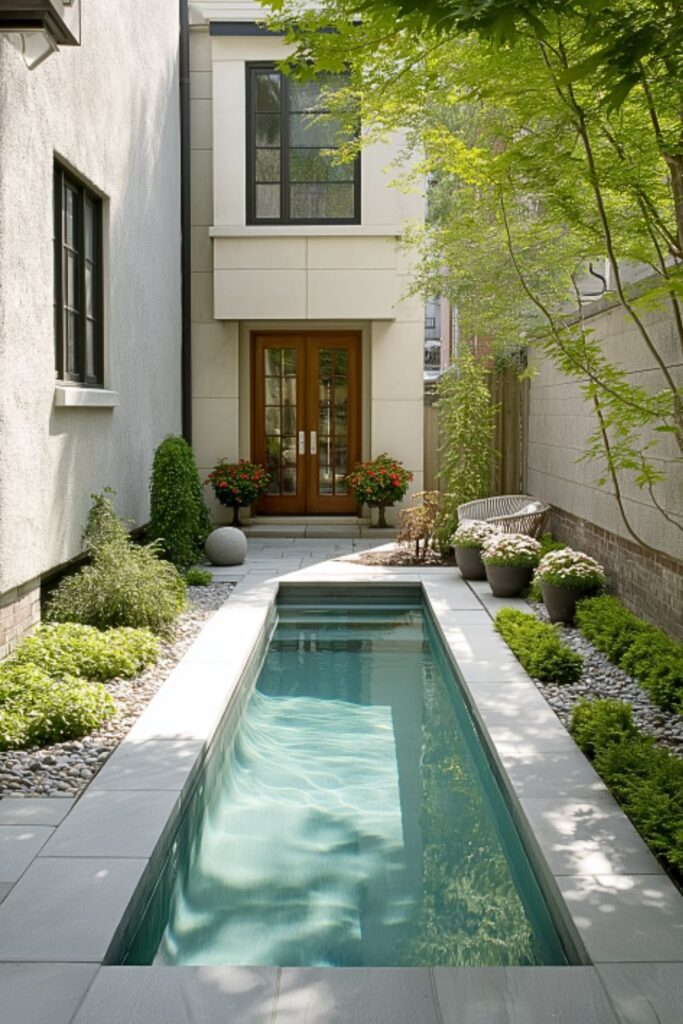
When square footage is limited, multifunctional and space-efficient features are the secret to creating a pool that feels luxurious. One standout option is a bench-style ledge that doubles as seating and steps. These can run the perimeter of the pool, offering both form and function.
Consider built-in water features like a wall fountain or scupper to add movement and sound without taking up floor space. Add a tanning shelf (also known as a Baja shelf) if you’d like a spot to relax partially submerged.
Designing up rather than out also helps. Raised edges can serve as extra seating, while raised planters provide greenery without compromising the pool footprint.
Space-Saving Features Table:
| Feature | Function | Visual Impact |
|---|---|---|
| Perimeter Benches | Seating, step access | Sleek and integrated |
| Wall-Mounted Waterfall | Sound, ambiance | Elegant focal point |
| Tanning Shelf | Lounging, child-safe space | Spa-like luxury |
| Raised Edge or Coping | Extra seating or planter space | Adds architecture and form |
Select Materials That Maximize Aesthetic Impact
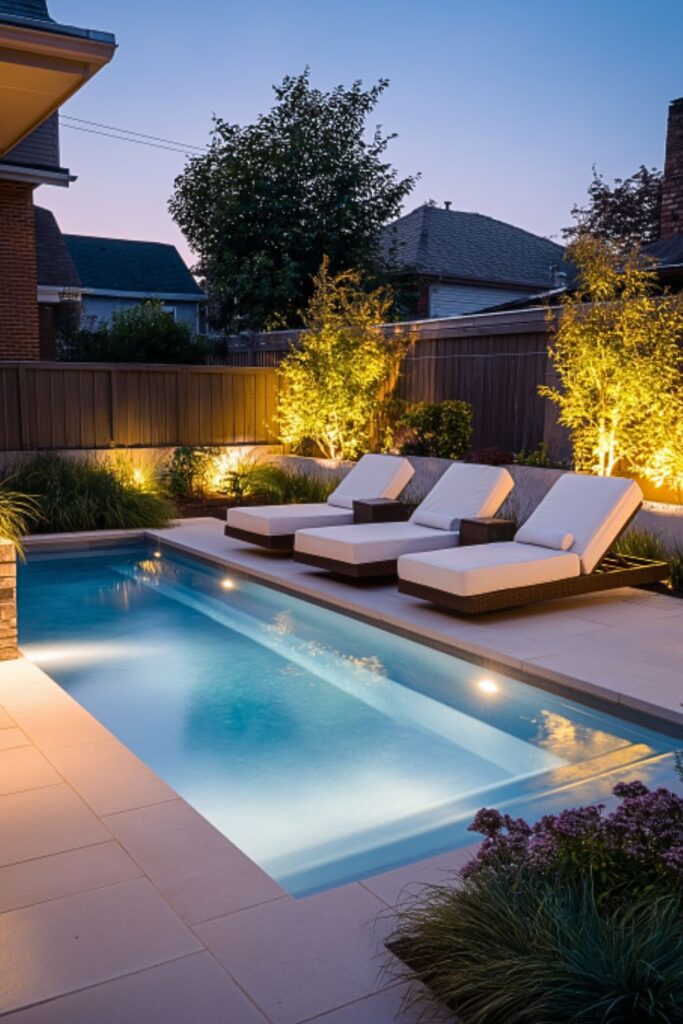
In small spaces, materials play a starring role. Since your pool is likely to be the focal point of the yard, every detail—from tile to decking—should be thoughtfully chosen to reflect your style and elevate the atmosphere.
Start with the interior finish. Glass tile offers light-catching shimmer and works well in compact pools to enhance visual depth. Lighter tones like aqua, pale blue, or pearl white can make the pool appear larger and more inviting. For a grounded, organic look, consider pebble-finish plaster or natural stone tiles in muted earthy tones.
Decking is equally important. Choose materials that are visually cohesive with your home and low-maintenance. Concrete pavers, natural stone, or composite decking are excellent options that balance durability and elegance.
Bordering elements like coping (the edge where pool meets deck) can be used to introduce contrast or continuity. For instance, a clean poured concrete coping paired with slate or bluestone decking creates a sleek modern feel.
If your style leans warm and rustic, opt for terracotta tiles or reclaimed wood decking with handmade ceramic tile accents. A small pool allows for splurging on premium materials since you’ll need less of them overall.
Material Ideas Table:
| Pool Element | Recommended Material Options | Aesthetic Effect |
|---|---|---|
| Interior Finish | Glass tile, pebble plaster, quartz | Reflective, textural, luxurious |
| Decking | Travertine, composite wood, concrete pavers | Warm, durable, cohesive |
| Coping | Brushed concrete, bullnose stone, ceramic tile | Frame-like, polished finish |
| Accent Details | Mosaic tile, matte black fixtures, LED lights | Customized, upscale design |
Create a Seamless Indoor-Outdoor Flow
Designing a pool that feels like an extension of your living space is a game-changer—especially for small yards. By connecting the pool area visually and physically to the interior of your home, you create a sense of continuity and luxury.
Floor-to-ceiling glass doors, matching flooring materials, and color palette repetition are great ways to blur boundaries. If your home opens to the pool area, consider aligning the pool with the main sightlines from inside. This not only maximizes visual impact but makes the outdoor space feel larger.
Consider also the placement of outdoor furniture, shade structures, and planters to create zones that mirror indoor comforts—such as reading nooks or alfresco dining areas near the pool.
Indoor-Outdoor Flow Table:
| Design Element | Implementation Tip | Benefit |
|---|---|---|
| Matching Flooring | Use similar materials inside and outside | Creates visual continuity |
| Sliding/Glass Doors | Open up indoor space to the pool | Expands perceived square footage |
| Exterior Styling | Use home’s colors in outdoor accents | Enhances cohesion |
| Mirror Zones | Lounge area outside, living area inside | Balanced lifestyle flow |
Embrace Landscaping That Frames, Not Crowds
A well-designed pool isn’t complete without landscaping—but in a small yard, greenery should enhance the space, not overwhelm it. The trick is to use plants to frame the pool while maintaining a clean layout that lets your design breathe.
Start with structure. Use vertical elements like slim trees (think olive, bamboo, or columnar junipers) to define boundaries and create privacy without taking up much ground space. These add height and visual layering.
For softness, add low-profile plantings like dwarf grasses, succulents, or lavender. Their low-maintenance nature and sculptural quality work beautifully around pools. Avoid shedding plants like deciduous trees that drop leaves, which can clog filters and create mess.
Incorporate containers and raised planters to keep things organized and off the ground. These can double as seating or dividers and are ideal for herb gardens or ornamental grasses.
Lighting also plays a key role. Uplighting on vertical plants or integrated LED strips along planters adds drama and elegance at night.
Smart Landscaping Table:
| Plant Type | Best Use | Maintenance Tip |
|---|---|---|
| Tall & Narrow Trees | Privacy and perimeter framing | Choose slow growers, minimal debris |
| Groundcover Plants | Fillers around decking | Use gravel mulch to minimize splashback |
| Potted Greens | Add color and mobility | Opt for glazed ceramic for style |
| Grasses & Herbs | Texture and movement | Drought-tolerant = less upkeep |
Conclusion
Designing a small pool for a small yard doesn’t mean compromising on luxury or style. In fact, with the right approach, limitations in size become opportunities for creativity, innovation, and stunning results. From choosing the perfect shape and material palette to incorporating smart features and landscaping that frames the scene, each element can be tailored to your lifestyle and design vision.
Ultimately, a well-designed small pool not only adds value to your home but enhances your everyday experience. With thoughtful planning and elevated design, even the tiniest backyard can make a lasting impression—both visually and functionally.

